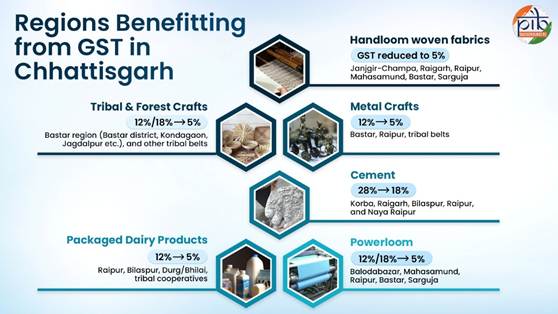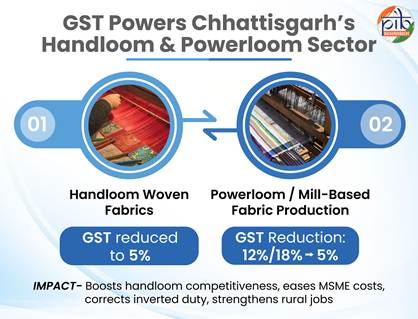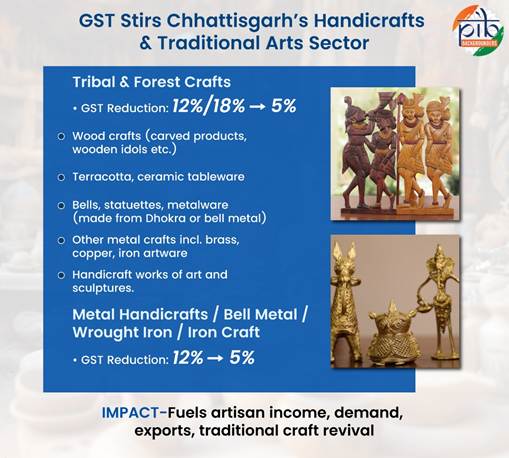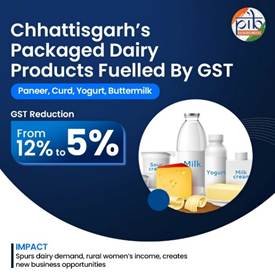From Cement to Handloom: GST Sparks Inclusive Growth in Chhattisgarh
From Cement to Handloom: GST Sparks Inclusive Growth in Chhattisgarh
Key Takeaways
17 October, 2025
Introduction
Chhattisgarh, located in central India, was formed in 2000 after its separation from Madhya Pradesh. It is the country’s 9th largest state and home to over 25 million people. Rich in forests and natural resources, the state is known for its tribal heritage, cultural vibrancy, and industrial strength. Its art and craft traditions- from Bastar’s bell metal work and Raigarh’s bamboo art to the handwoven Kosa silk fabrics- reflect a living legacy of skill and sustainability.
Recent GST reforms offer a fresh momentum to Chhattisgarh’s economy. By lowering tax rates on essential goods and traditional sectors, these reforms reduce input costs, stimulate consumer demand, and make local products more competitive in national and global markets. The 5% GST rate on key sectors such as handlooms, handicrafts, and dairy not only eases the burden on small producers but also encourages formalisation and rural entrepreneurship, aligning with the state’s developmental priorities and inclusive growth vision.

Cement Industry
In Chhattisgarh, the cement and building materials industry has a strong presence across Korba, Raigarh, Bilaspur, Raipur, and Naya Raipur- regions experiencing rapid development and urbanization. This industry plays a vital role in the state’s economy, contributing through tax revenues and supporting ancillary industries. It also ranks among the largest employers in Chhattisgarh-

The reduction of GST on cement from 28% to 18% makes cement more affordable, lowering construction costs, stimulating housing demand, and generating additional employment opportunities in the infrastructure sector.
Handloom & Powerloom Sector
The handloom industry is one of Chhattisgarh’s most prominent cottage industries, deeply rooted in its cultural and economic fabric. Alongside, the state’s MSME and powerloom workforce plays a key role in supporting India’s larger textile ecosystem- one of the country’s biggest industrial contributors and a major source of national textile output.
Handloom Woven Fabrics
In Chhattisgarh, districts such as Janjgir-Champa, Raigarh, Raipur, Mahasamund, Bastar, and Sarguja form the crux of the state’s handloom network. Handloom woven fabrics include terry towelling and similar woven terry fabrics. The cotton handloom clusters of Raipur, Durg, Mahasamund, and Bastar, along with the tussar and kosa silk of Janjgir-Champa and Raigarh showcase the region’s artisanal excellence.
The GST reduction to 5% further energizes this sector, making handwoven sarees and kosa/tussar silk fabrics more affordable and globally competitive. This gives a significant boost to Indian handloom products in export markets. The move not only stimulates consumer demand and boosts sales, but also empowers weavers, helping them compete effectively against cheap, machine-made textiles while sustaining Chhattisgarh’s weaving traditions- particularly benefitting the internationally recognized kosa/tussar silk.

Powerloom / Mill-Based Fabric Production
Powerloom weaving in Chhattisgarh is a semi-organized industrial activity, concentrated in clusters around Raigarh, Bilaspur, and Janjgir-Champa, with key hubs in Balodabazar, Mahasamund, Raipur, Bastar, and Sarguja.
Recent GST reforms, trimming rates from 12%/18% to 5% offer a substantial boost to this sector. As the textile industry is India’s second-largest employer, favourable tax policies help sustain and create jobs, reduce input costs, improve margins, and enhance the global competitiveness of Indian textiles, boosting exports. Notably, the reforms are a relief for MSMEs as they ease the input tax burden, correct inverted duties, support working capital, and encourage formalization.
Handicrafts & Traditional Arts Sector
Beyond its tribal heritage, Chhattisgarh is famous for its diverse art and craft traditions. The state is home to various forms of metal, clay, and wood art, each reflecting deep-rooted cultural expression and craftsmanship. From the Dhokra metal casting and Bastar’s wooden carvings to its bell metal artifacts, Chhattisgarh’s artisans display skill and creativity. The state’s jewellery, textiles, and terracotta crafts blend traditional aesthetics with contemporary appeal.
Tribal & Forest Crafts
The Bastar region- including Bastar, Kondagaon, and Jagdalpur, along with other tribal belts of Chhattisgarh, is renowned for its tribal and forest crafts. The state’s artisans create a wide variety of products such as wooden artifacts, Dhokra metalwork, wrought iron, bamboo, terracotta, and bell metal crafts, reflecting the cultural heritage and natural wealth of the region.
The GST rate cut (from 12%/18% to 5%) increases demand by 10-15% and potentially adds 5,000 new jobs by 2026. Additionally, the reform enhances margins, boosts sales, and strengthens artisan livelihoods, particularly for those organized into Self-Help Groups (SHGs). The lower tax on raw materials such as tendu leaves further supports the income stability of tribal communities engaged in these traditional crafts.

Traditional Arts Sector- Metal Handicrafts / Bell Metal / Wrought Iron / Iron Craft
Metal handicrafts & bell metal / wrought iron / iron craft are practiced widely across Bastar, Raipur, and other tribal regions of Chhattisgarh, forming an integral part of the state’s artisanal economy. The Bastar Iron Craft (Dhokra art) holds a Geographical Indication (GI) tag, highlighting its cultural significance and traditional production techniques. This sector sustains thousands of livelihoods, particularly within the Bastar–Kondagaon clusters, and is actively promoted under the One District One Product (ODOP) initiative.
The GST reduction to from 12% to 5% provides a major boost to this sector by lowering production costs, improving sales, and supporting exports. The reform offers financial relief to tribal artisans, helping make their craft economically viable again while preserving traditional skills that were under strain from higher tax slabs.
Packaged Dairy Products
In Chhattisgarh, particularly in Raipur, Bilaspur, Durg/Bhilai, and tribal cooperative regions, dairy farming is a crucial livelihood, especially for women in rural and tribal communities. The state has over 1,068 dairy cooperative societies, with a significant number being women-led.

GST on packaged dairy products such as paneer, curd, yogurt, and buttermilk has been reduced from 12% to 5%. This reduction is expected to stimulate consumer demand, necessitating robust cold chain infrastructure for transport and storage. The policy not only creates new business opportunities and supports organized dairy production but also strengthens women-led rural enterprises, enhancing economic prospects for dairy farmers in these regions.
Conclusion
The recent GST reforms in Chhattisgarh- reducing rates across handlooms, handicrafts, metal and forest-based arts, packaged dairy, and cement- lowers production costs, boosts consumer demand, and enhances competitiveness. These measures empower women-led rural enterprises, sustains thousands of artisans, and supports organized industrial employment, while stimulating exports and formalization. By strengthening livelihoods, preserving traditional skills, and fostering new business opportunities, GST reforms are driving inclusive growth and positioning Chhattisgarh for sustainable socio-economic development.
References
cgstate.gov.in
incredibleindia.gov.in
https://www.incredibleindia.gov.in/en/chhattisgarh
cgapexhandloom.org.in
https://www.cgapexhandloom.org.in/portal/about-us
IBEF
https://ibef.org/exports/powerloom-industry-in-india
tourism.cgstate.gov.in
https://tourism.cgstate.gov.in/themes/Ethnic-Tribal
repository.tribal.gov.in
https://repository.tribal.gov.in/handle/123456789/74989?viewItem=browse